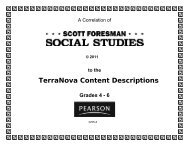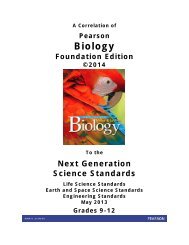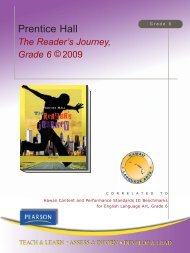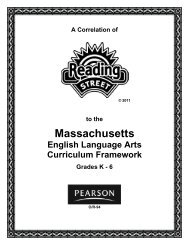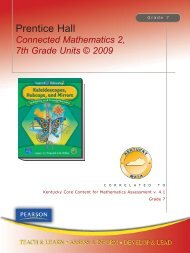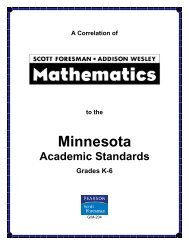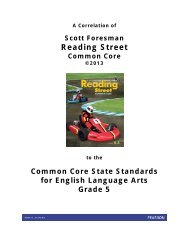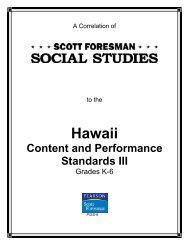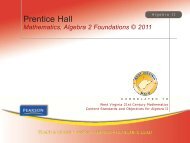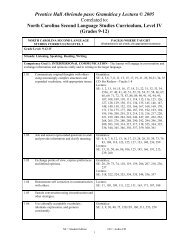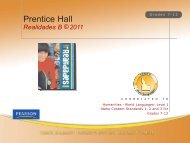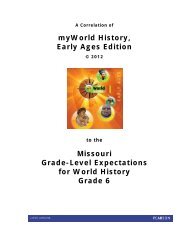Miller & Levine Biology - Pearson
Miller & Levine Biology - Pearson
Miller & Levine Biology - Pearson
Create successful ePaper yourself
Turn your PDF publications into a flip-book with our unique Google optimized e-Paper software.
HS-LS4 Biological Evolution: Unity and DiversityA Correlation of<strong>Miller</strong> & <strong>Levine</strong> <strong>Biology</strong>, ©2014to the Next Generation Science Standards, May 2013Grades 9-12HS-LS4 Biological Evolution: Unity and DiversityStudents who demonstrate understanding can:HS-LS4-1. Communicate scientific information that common ancestry and biological evolution are supported by multiplelines of empirical evidence. [Clarification Statement: Emphasis is on a conceptual understanding of the role each line of evidence has relating to common ancestry andbiological evolution. Examples of evidence could include similarities in DNA sequences, anatomical structures, and order of appearance of structures in embryological development.]MILLER & LEVINE BIOLOGY: Lesson 16.1 (pp. 450–453) describes what Darwin observed during the voyage of the Beagle. Lesson 16.3(pp. 460–464) presents Darwin’s argument for evolution by natural selection. In Lesson 16.4 (pp. 465–463), students learn about otherempirical evidence that supports Darwin’s argument. Lesson 17.4 (pp. 498–501) presents the molecular evidence for evolution.Students communicate scientific information about the multiple lines of evidence for biological evolution: Students write a paragraphexplaining how evidence since Darwin’s time has strengthened his theories (Q6, p. 473). Students write and refine a paragraph about howdescent with modification can explain the diversity of life today (Q19, p. 477). Students write a paragraph explaining how Earth’s agesupports the theory of evolution (Q35, p. 478). Students write a newspaper article about the theory of evolution for an audience that knowsnothing about the subject (Q37, p. 478).HS-LS4-2. Construct an explanation based on evidence that the process of evolution primarily results from four factors: (1)the potential for a species to increase in number, (2) the heritable genetic variation of individuals in a species due tomutation and sexual reproduction, (3) competition for limited resources, and (4) the proliferation of those organisms thatare better able to survive and reproduce in the environment. [Clarification Statement: Emphasis is on using evidence to explain the influence each of thefour factors has on number of organisms, behaviors, morphology, or physiology in terms of ability to compete for limited resources and subsequent survival of individuals andadaptation of species. Examples of evidence could include mathematical models such as simple distribution graphs and proportional reasoning.] [Assessment Boundary: Assessmentdoes not include other mechanisms of evolution, such as genetic drift, gene flow through migration, and co-evolution.]MILLER & LEVINE BIOLOGY: The foundation for understanding the evidence for evolution is laid in Lesson 4.2 (pp. 100–101) where thecompetitive exclusion principle is discussed; in Lessons 5.1 and 5.2 (pp. 139–141) where population growth and limits to growth arediscussed; and in Lesson 13.3 (pp. 372–376) where mutations are discussed. In Lesson 16.3 (pp. 460–464), students are introduced to theconcept of natural selection. In Lesson 17.2 (pp. 487–489), students learn about the impact of genetic variation on natural selection. In theChapter 17 Lab, Competing for Resources, students use assorted tools to simulate the competition of birds for seeds.Students construct an explanation based on evidence that evolution results primarily from four factors: Students use experimental datato explain how genetic variation is important in the survival of a species (Q5b, p. 473). Students explain how the process of natural selectionaccounts for the diversity of the organisms that Darwin observed on the Galápagos Islands (Q23, p. 477). Students describe three lines ofevidence that support the theory of evolution (Q36, p. 478).HS-LS4-3. Apply concepts of statistics and probability to support explanations that organisms with an advantageousheritable trait tend to increase in proportion to organisms lacking this trait. [Clarification Statement: Emphasis is on analyzing shifts in numericaldistribution of traits and using these shifts as evidence to support explanations.] [Assessment Boundary: Assessment is limited to basic statistical and graphical analysis. Assessmentdoes not include allele frequency calculations.]MILLER & LEVINE BIOLOGY: In Lesson 16.3 (pp. 460–463), students learn how advantageous traits affect survival. In Lesson 16.4 (pp.471–473), students learn how scientists can observe natural selection in a natural environment.Students apply concepts of statistics and probability to the relationship between advantageous traits and population size: Studentsidentify a trend in bird survival based on beak size (Figure 16-18, p. 473). Students use statistics to explore drug resistance as anadvantageous trait for bacteria (Analyzing Data, p. 591). Students learn how the presence of mycorrhizae affects the growth and survival ofplants (Analyzing Data, p. 624).HS-LS4-4. Construct an explanation based on evidence for how natural selection leads to adaptation of populations.[Clarification Statement: Emphasis is on using data to provide evidence for how specific biotic and abiotic differences in ecosystems (such as ranges of seasonal temperature, longtermclimate change, acidity, light, geographic barriers, or evolution of other organisms) contribute to a change in gene frequency over time, leading to adaptation of populations.]MILLER & LEVINE BIOLOGY: Lesson 17.1 (pp. 482–486) introduces the concepts of a gene pool and allele frequency. In Lesson 17.2(pp. 487–492), students learn how natural selection affects allele frequencies. In Lesson 17.3 (pp. 494–497), students learn how differenttypes of isolation can lead to the adaptation of populations.Students construct an explanation based on evidence for how natural selection leads to adaptation of populations: Students explainwhy rapid evolution is likely to occur in a small population that has been separated from the main population (Q19, p. 566). Studentsexplain how the evolution of a vascular system affected the ability of plants to survive in various environments (Q2, p. 657). Studentsexplain why it is adaptive for seeds to remain dormant before they germinate (Q3b, p. 707).SE = Student Edition; TE = Teacher’s Edition; LMA = Lab Manual A 15



